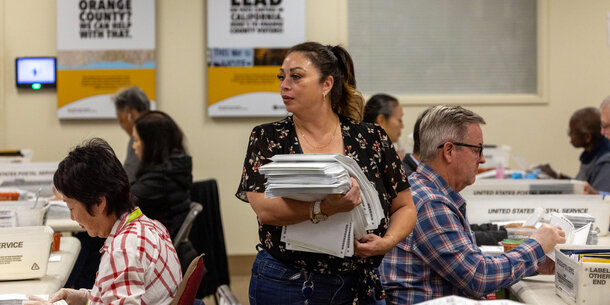You’re reading The Briefing, Michael Waldman’s weekly newsletter. Click here to receive it every week in your inbox.
Two North Carolina lawmakers, after seeing the state supreme court strike down their heavily gerrymandered congressional map, are now making an audacious argument to the U.S. Supreme Court. Not just that the state court erred in rescinding their map, but that it has no power to review any of the legislature’s decisions in administering congressional elections.
The lawmakers’ bid to eliminate state-level checks on gerrymandering and voter suppression is based on a dubious reading of the Constitution known as the “independent state legislature theory.” Their appeal in Moore v. Harper, and the independent state legislature theory itself, took a big hit last week. The Conference of Chief Justices filed a potentially case-turning amicus brief.
The significance of the brief is not just in what it says but in who is saying it. Many (including yours truly) have argued that the independent state legislature theory is contrary to the original understanding of the U.S. Constitution as well as 200 years of U.S. elections practice. Some of the framers themselves voted for state constitutions that curtailed the legislature’s power in elections administration. The independent state legislature theory would render those provisions nonsensical. This fact, along with many others damning to the independent state legislature theory, is well established.
But the Conference of Chief Justices is no ordinary friend of the court. The group is comprised of the chief justice or judge of the highest court in all 50 states, the District of Columbia, as well as U.S. territories like Puerto Rico. The state judges speak to the U.S. Supreme Court as representatives of sovereign governments, and they remind the justices that the independent state legislature theory threatens that sovereignty.
“State sovereignty includes the power of each state to structure its own government and determine the relationships between the legislative and judicial branches,” the conference points out. The independent state legislature theory would represent a Supreme Court–mandated carve-out to each state’s sovereignty — barring state judicial review of any legislative decision relating to congressional elections.
If the framers intended to interfere so profoundly in the inner workings of state governments, they would have made that intervention explicit. But they did not. To the contrary, the Bill of Rights notes that powers not expressly delegated to the federal government are “reserved to the states respectively, or to the people.”
Officially, the Conference of Chief Justices brief does not support either party in the case. But the arguments it makes expose the logical inconsistencies and dangers of the independent state legislature theory and correctly identify it as an attack not just on citizens’ voting rights but on our federalist system as well.
Friend-of-the-court briefs can sometimes turn the tide in major Supreme Court cases. In 2003, for example, dozens of former high-ranking officers and military leaders signed a friend-of-the-court brief supporting the consideration of race in college admissions, which they regarded as critical to maintaining a diverse and highly qualified officer corps. At oral argument, when the solicitor general rose to attack affirmative action, he was unable to complete his second sentence before Justice John Paul Stevens interrupted to ask him about the military officers’ brief. Court observers agree the brief was critical to the outcome of the case. (Perhaps not coincidentally, the attorney who filed that brief is also the attorney of record on the Conferences of Chief Justices’ brief in Moore.)
For at least a decade, the Supreme Court has disappointed supporters of voting rights. It eviscerated the Voting Rights Act and turned a blind eye to partisan gerrymandering. Many worry that Moore will continue that trend. The Conference of Chief Justices, however, has thrown the justices a curveball. This is no longer just a voting rights case — it’s a federalism case.



